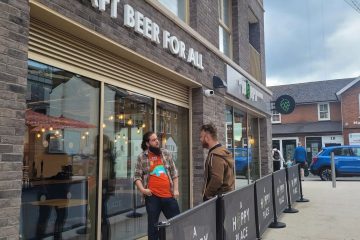Whilst having a mostly friendly discussion with a Polish truck driver about #Brexit in a basement bar north of the Belfort in Bruge, I had possibly the best beer experience of my life to date. I think. Some of the details are fuzzy.
Naomi and I had known for some time now that if there’s any beer we didn’t know enough about, it was the Belgian styles. Whilst we are both big fans of Saison Dupont, or Duvel and Chimay, and can get a couple of the Trappist beers from suppliers around us, our knowledge of the style was perhaps a little lacking.
So we knew we had to patch this glaring deficiency – we work in the industry, we sell, but I frankly didn’t know the difference between a Dubel and a Tripel. It was sad. So this was on the mind for quite some time, and in passing conversation bringing up my planned trip at our local CAMRA committee meeting, our secretary Paul made me the fantastic offer of loaning me some of his extensive books on Belgian beer. And I must say, though he did make warning of just how much he had on the subject – I still couldn’t believe my eyes returning from a hard day at the office to the sight of about 12 textbooks through the letter box. This knowledge in hand, I set off on planning a tour of both Bruges and Brussels.

Our stops in Bruges were the Half Moon Brewery, Le Trappiste, Café Canbrinus, the excellent Bruges staple joint ‘t Brugge Beertje (The Bruges Bear – famous in their history for failing to prevent a Noble daughter from being kidnapped as I understood it – I was a bit drunk) The Beer Wall 2be, and, well, the rest of the history is a bit hazy for some reason. It’s almost as if the famously strong Belgian styles had somehow impacted my memory! But it was at Le Trappiste that, Angry Truck Driver aside (I’m told the next group he tried to speak to after us, ‘took it outside’, and prompty decked the fella. He left), we had our Belgian Beer Epiphany…

I won’t spend time discussing the history of Trappist beers at length owing to the fact that hundreds of other writers have covered it before. What I will do is briefly share the history of one brewery.
Westvleteren in Saint Sixtus were founded in 1838 and are the producers of by far and away one of the most difficult to get ahold of highly renowned beers in the world. Ratebeer gives their Westvleteren 12 100/100 on both measures. They only sold their beer to the public for 13 years, between 1931 and 1946. Thereafter, the monks of St Bernardus took over the mantle – brewing the beer under license for nearly 50 years before Westvleteren themselves brought it back in house. Given St Bernadus still produces a beer then, our task this night was simple – judge whether we truly felt the St Bernardus 12 and Westvleteren 12 were the same.
Why was this important? Because Westvleteren will sell you one case of Westvleteren 12 per appointment, which you must make 2-3 months in advance, pre providing your Belgian numberplate when booking. If you can find it for sale, expect to pay 15 to 20 Euros. St Bernardus is on Beerwulf for less than £3 a bottle. This mysticism certainly adds to the hype, but does the hype stand to judgement when push comes to shove…

It was then, in La Trappiste, next to the angry Polish truck driver, that we ordered the most expensive round of Beers I’ve ever ordered. Forget £22 a pint, how about 48 Euros for less than a litre of beer.

On the left, we had St Bernardus 12, in the middle – a 2018 Westvleteren 12, and on the right, a 2013 Westvleteren 12, aged in cold storage for 5 full years by the bar – for just 5 euros more. Surely a better storage fee cannot be found. I was excited.
Comparing the two beers, I would say that as expected, beer clarity, aroma, colour, head retention and body were all markedly similar. However – the same malt bill, the same hops, the same methods, did not make the same beer.
Both beers are a dark reddish brown, both with on our tasting a slight haze. Both with the kind of aromas you’d expect from an excellent quad: Plum, Caramel, Raisins, and perhaps Chocolate or spices of sorts as the glass warms up. However to our tastes, there was a slight difference.
The 2013 predictably, had more caramel, more plum, and was moving towards a port kind of a character, but was certainly still recognisable as a Belgian quad. It was the first beer I have ever given 5/5 on my untappd account. I was drunk but I think I stand by it. It’s a shame I didn’t take a second aged bottle away, but in a few years I’ll repeat the experiment
Pontificating on why the St Bernardus and the Westvleteren quads did differ: It surprised me to learn that whilst St Bernardus still use the original Westvleteren Ale Yeast strain, that Westvleteren themselves now use a Westmalle strain. Now I assume and put down the slight differences in the beer to this, because to my knowledge the method for brewing is otherwise identical. If you know more, let me know.
Regardless, For whatever reason, the Westvleteren 12 (IE the Westmalle strain! Confusion abounds .. ) yeast to my taste was performing better. There seemed to be a slightly phenolic quality, and a slight remainder of fusel alcohols, to the St Bernardus beer. That’s not to say it’s a bad beer, it’s an astounding beer – but the Westvleteren is slightly sweeter, for me: Slightly more balanced – and thus wins it. Just. It may even be that the St Bernardus IS perfectly balanced for a belgian quad, it’s just that to my palette it falls slightly short of the Westie …
I’m even quite confident asked to taste blind I could work out which was which. Test me some time if you fancy donating a Westy to us!
That mammoth task dispatched, we moved on from Bruges back to Brussels and took a tour of the Cantillon brewery, just south of Brussels in Anderlecht. What I would say up front, is get a cab from the centre of Brussels to the brewery, it’s… not that nice down there. Once there however we were treated to an absolute delight of belt driven machinery, rickety stairs, imminent risk of death, spider’s webs, weeping barrels and fantatic authentic Lambic. The Belgian Lambic process is a truly wild fermentation, and at least a year from Wort to glass. The spiders are a natural way of stopping flies settling in the FVs, or so we were enthusiastically told by a truly excellent tour guide. We had a great time, and I’ll let the pictures do the talking. I thoroughly recommend this tour to anyone who visits Brussels. Just be sure to book ahead as it’s very popular.

Our evening consisted of trips to the Delirium Tremens bar, Moeder Lambic Fountainas, Poechenellekelder and A La Morte Subite. I absolutely loved the atmospheres at Delirium, touristy or not, and especially at Moeder Lambic. I aspire to create the vibe they have, though, I might not personally throw Steel Panther’s Gloryhole through a multi-room Sonos system too often? I’ll blow my load somewhere else…

Long story short, if I could go back, I’d do more time in Bruges though, the history of the town is astounding. It’s also the only town I know of with an underground plumbed in beer line (running about 3.5km from the Half Moon brewery to their bottling facility, a crowdfunded venture to help get beer trucks off the cobbled streets). It’s one of the prettiest towns in Europe to boot. It might take me a bit longer to go back to Brussels again, but the beer scene does make it worth-while, and perhaps if you particularly want to check out Manneken Pis for some unfathomable reason, there’ll be more for you besides.
Many styles of Belgian Ale, Blondes, Dubels Tripels and Quads, plus a few zany sours and blends, are for sure going to festoon the shelves of the bottle shop. We started by bringing back 20 kilos of hard to find belgian bottles, to keep working on our palettes and to offer to friends and colleagues…. We might even have snuck back a bottle or two of Westvleteren 12 for a special occasion. Speak to us if you fancy a suggestion, some information about the styles, or if there’s some beer you want us to find, that Untappd doesn’t already say we have! We’ll do our best to keep you covered, and to serve this superb style of beer.
Cheers!



0 Comments